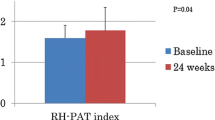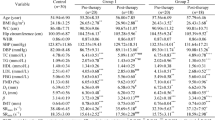Abstract
Background and Objective
Administration of 0.4 to 0.8 mg of cerivastatin per day for 2 weeks has been reported to have pleiotropic effects and improve endothelial function. Whether low-dose cerivastatin would produce these rapid pleiotropic effects in the clinical setting remains uncertain, however. We investigated the effect of short-term therapy with relatively low-dose cerivastatin (0.15 mg/day) on endothelial function, thrombostatic parameters, and C-reactive protein (CRP) levels in hypercholesterolemic patients.
Methods
Thirteen patients with LDL-cholesterol>160 mg/dl were treated with daily doses of 0.15 mg of cerivastatin for 2 weeks. Endothelial function, thrombostatic parameters (tissue-type plasminogen activator [t-PA], plasminogen activator inhibitor type 1 [PAI-1], and CRP were estimated at baseline and again after 2 weeks of treatment. Endothelial function was measured as flow-mediated vasodilation. Flow-mediated vasodilatation was assessed by measuring the percent change in the diameter of the brachial artery in response to reactive hyperemia using high-resolution ultrasound. Endothelium-independent vasodilatation was also measured using sublingual nitroglycerin.
Results
No major complications developed after the treatment. Total cholesterol decreased significantly, from 258±32 to 211±21 mg/dl, and LDL-cholesterol also decreased from 171±15 to 133±16 mg/dl after the treatment. Flow-mediated vasodilatation increased significantly, from 4.6±1.3 percent to 8.7±3.5 percent after 2 weeks of therapy, although endothelium-independent vasodilatation was not affected (9.5±2.4% vs 8.8±3.1%). No relation was found between percent change in flow-mediated vasodilatation and improvement in levels of LDL-cholesterol after therapy (r=0.07). PAI-1, t-PA, and CRP were not significantly changed by 2 weeks of therapy.
Conclusions
(1) Evaluating vasodilation of the brachial artery with B-mode ultrasound imaging was useful in investigating the effect of statin on endothelial function. (2) Although no effect was detected in PAI-1, t-PA, or CRP, relatively low-dose cerivastatin therapy for 2 weeks improved endothelial function and lipid level independently and safely in hypercholesterolemic patients.
Similar content being viewed by others
References
Shepherd J, Cobbe SM, Ford I, et al: Prevention of coronary heart disease with pravastatin in men with hypercholesterolemia.N Engl J Med 1995;333: 1301–1307.
Sacks FM, Pfeffer MA, Moye LA, et al: The effect of pravastatin on coronary events after myocardial infarction in patients with average cholesterol levels.N Engl J Med 1996;335: 1001–1009.
WOS-COPS Study Group. Influence of pravastatin and plasma lipids on clinical events in the West of Scotland Coronary Prevention Study.Circulation 1998;97: 1440–1445.
Egashira K, Hirooka Y, Kai H, et al: Reduction in serum cholesterol with pravastatin improves endothelial-dependent coronary vasomotion in patients with hypercholesterolemia.Circulation 1994;89: 2519–2524.
John S, Delles C, Jacobi J, et al: Rapid improvement of nitric oxide bioavailability after lipid-lowering therapy with cerivastatin within two weeks. J Am Coll Cardiol 2001;37: 1351–1358.
Aikawa M, Rabkin E, Sugiyama S, et al: An HMG-CoA reductase inhibitor, cerivastatin, suppresses growth of macrophages expressing matrix metalloproteinases and tissue factor in vivo and in vitro.Circulation 2001;103: 276–283.
Ridker PM, Rifai N, Pfeffer MA, et al: Long-term effects of pravastatin on plasma concentration of C-reactive protein.Circulation 1999;100: 230–235.
Ridker PM, Rifai N, Lowenthal SP: Rapid reduction in C-reactive protein with cerivastatin among 785 patients with primary hypercholesterolemia.Circulation 2001;103: 1191–1193.
Tsunekawa T, Hayashi T, Kano H, et al: Cerivastatin, a hydroxymethylglutaryl coenzyme A reductase inhibitor, improves endothelial function in elderly diabetic patients within 3 days.Circulation 2001;104: 376–379.
Hunninghake D, Insull W, Knopp R, et al: Comparison of the efficacy of atorvastatin versus cerivastatin in primary hypercholesterolemia.Am J Cardiol 2001;88: 635–639.
Matsuda Y, Akita H, Terashima M, et al: Carvedilol improves endothelium-dependent dilatation in patients with coronary artery disease.Am Heart J 2000;140: 753–759.
Zeiher AM, Drexler H, Saurbier B, et al: Endothelium-mediated coronary blood flow modulation in humans. Effects of age, atherosclerosis, hypercholesterolemia, and hypertension.J Clin Invest 1993;92: 652–662.
Egashira K, Inou T, Hirooka Y, et al: Impaired coronary blood flow response to acetylcholine in patients with coronary risk factors and proximal atherosclerotic lesions.J Clin Invest 1993;91: 29–37.
Laufs U, Fata VL, Plutzky J, et al: Upregulation of endothelial nitric oxide synthase by HMG-CoA reductase inhibitors.Circulation 1998;97: 1129–1135.
Gonzalez-Fernandez F, Jimenez A, Lopez-Blaya A, et al: Cerivastatin prevents tumor necrosis factor-α-induced downregulation of endothelial nitric oxide synthase: role of endothelial cytosolic proteins.Atherosclerosis 2001;155: 61–70.
Hernandez-Perera O, Perez-Sala D, Navarro-Antolin J, et al: Effects of the 3-hydroxy-3-methylglutaryl-CoA reductase inhibitor, atorvastatin and simvastatin, on the expression of endothelin-1 and endothelial nitric oxide synthase in vascular endothelial cells.J Clin Invest 1998;101: 2711–2719.
Kaesemeyer WH, Caldwell RB, Huang J, et al: Pravastatin sodium activates endothelial nitric oxide synthase independent of its cholesterol-lowering actions. J Am Coll Cardiol 1999;33: 234–241.
Lacoste L, Lam JY, Hung J, et al: Hyperlipidemia and coronary disease. Correction of the increased thrombogenic potential with cholesterol reduction.Circulation 1995;92: 3172–3177.
Strandberg TE, Vanhanen H, Tikkanen MJ: Effect of statins on C-reactive protein in patients with coronary artery disease.Lancet 1999;100: 230–235.
Furberg CD, Pitt B: Withdrawal of cerivastatin from the world market. Curr Control Trials Cardiovasc Med 2001;2: 205–207.
Author information
Authors and Affiliations
About this article
Cite this article
Sakabe, K., Fukuda, N., Nada, T. et al. Short-term therapy with relatively low-dose cerivastatin improves endothelial function independently of its lipid-lowering effect: Evaluation of brachial artery vasodilatation using B-mode ultrasound imaging. J Med Ultrasonics 29, 225–230 (2002). https://doi.org/10.1007/BF02480853
Received:
Accepted:
Issue Date:
DOI: https://doi.org/10.1007/BF02480853




